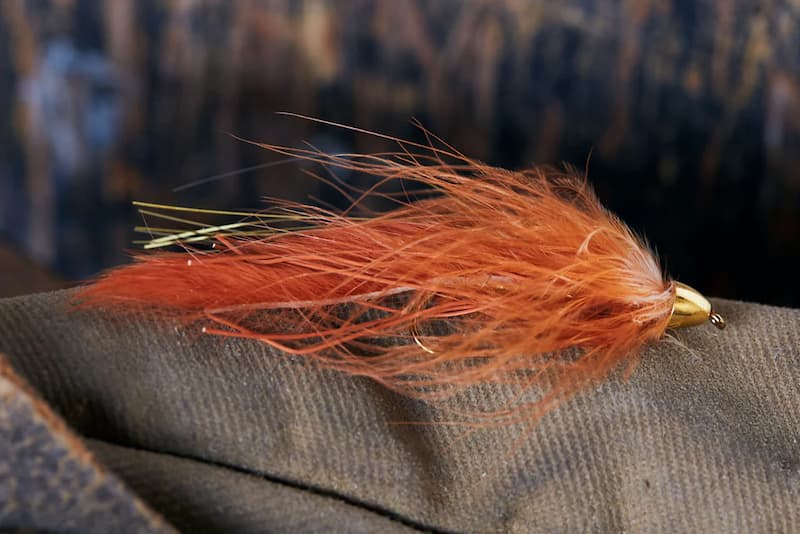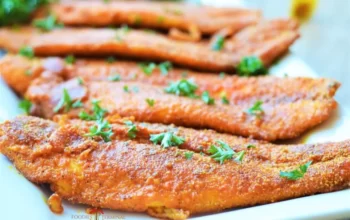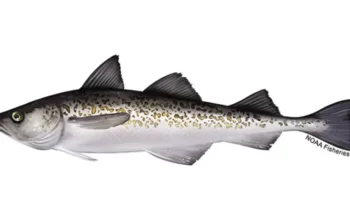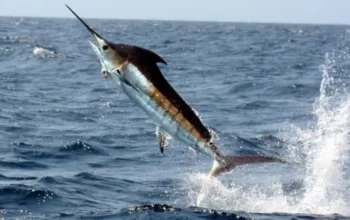First, what is a fly fishing streamer?
In fly fishing, a streamer is a fly (lure) that imitates a bait. Examples of what a streamer imitates: minnows, shad, crayfish and other aquatic bugs. Typically, a hook wrapped in natural (feathers and fur) or synthetic (polyester and Mylar) materials is used to make streamers. Fly casting and retrieving the streamer fly is known as streamer fishing.
Please continue reading so I can show you the post’s more detailed information.
Table of Contents
Streamer Fishing: What Is It?
Fly fishing with a submerged fly, or “streamer,” is known as “streamer fishing.” A streamer is designed to resemble a “bait-fish,” or a smaller fish, such as a sculpin or a minnow, that larger fish typically like to feed on. Leeches, crayfish, and other underwater morsels that larger fish like to eat can also be caught on streamer flies. Sizes of the fly can vary greatly between small and simple wooly buggers, all the way to complexed articulated flies that stretch the size of your hand.
Given that they are fished with an active retrieve, streamers are typically fished with greater attention than the conventional dry-fly or nymph rig. This indicates that the angler’s stripping in line to draw the fly back for another cast is what primarily moves them.
Why Use A Streamer?
When it comes to answering why to use a streamer as opposed to a different fly setup, the main reason is simple: big fish need lots of protein to survive, and in turn, will attack big flies when given the chance. For a variety of reasons, such as hunger, territorialism, or simple instinct, aggressive fish frequently attack meaty snacks.
Another excellent way to cover a lot of water quickly is with streamers. An angler can cover entire pools quickly and often successfully by employing the cast and retrieve techniques listed here.
As it is very involved and frequently results in violent strikes when a fish decides to take the fly, streamer fishing can be one of the most thrilling types of fly fishing. Every angler can recall the first time they experienced or witnessed a fish attack a streamer with vigor.
Not just fish that are hungry are involved! Fishing streamers as opposed to other types of tackle has many benefits. drifting nymphs and tossing dries, is that it’s a great way to hook fish that aren’t actively feeding. Streamer fishing oftentimes triggers reactionary strikes in predatory fish such as trout, bass, and other large underwater game. A reactionary strike occurs when your fly drifts past a fish that is hunkered down and the fish swipes at it instinctively rather than out of hunger. These fish have grown so large for a reason, and that reason is that they don’t take crap from anyone.
When To Use A Streamer?
A recent rainstorm has there been? Are there no observable insects in the area? Is it deep and murky in the water? These are all factors to consider when determining whether or not to throw on a streamer.
A streamer might be a good substitute for topwater or nymphs if you’re having trouble matching the hatch or even recognizing any nearby insects. Often times, this may be due to temperature factors. Trout especially are at full energy at around 55-60 degrees F, and may not be rising if the water is too cold, or too hot. Although it isn’t a guarantee, putting a substantial meal in front of them will probably make them much more likely to accept it.
Oftentimes, streamers can be a great way to increase your fly’s visibility and ability to sink in murky or deep water (typically following a rainstorm). Fish will be less likely to swipe at large streamers in clear water and bright light because the thicker tippet may be easier to see and there are probably plenty of insects around to feed on. Smaller and more subdued streamers will work better if you choose to use them to fish in clear water.
Where To Use A Streamer?
The best places to hunt for streamers are protected areas like banks, large rocks, around submerged logs or trees, along the seams of currents, and in deep pockets of water.
Look for cover: Regardless of size, predators exist for all fish. Fish are innately drawn to cover and protection, just like birds, people, and larger aquatic animals are. such as submerged debris (i.e. trees) act as a great hiding spot, not only for fish to hide from predators, but to wait and lurk for prey to swim by (in this case, that’ll be your fly).
Fish the seam: For any angler to have a solid understanding of the water, checking the seam is essential. Fish can hang out and conserve energy in a small pocket created by the seam, which is an invisible line in the water where two current speeds meet. Additionally, they serve as underwater lanes where fish can wait in the still water for meals like insects or idly scurrying minnows to wash down directly into their mouths.
Fish deep: The golden rule of streamer fishing is that you should always fish in deep water. Two things are probably true if you’re fishing in a body of water where you can’t see the bottom: 1. visibility is low, and if the fish can’t see your fly they can’t eat it, and 2, there are big hungry fish down there.
The majority of streamers are made with flashy components to draw fish in. They’re more likely to be noticed than microscopic nymphs when they’re flashing through the gloomy water. Not to mention, the fish hiding in those deep pools are not fingerlings. No, they are large bully fish that are patiently waiting for a REAL meal, which will likely include your big, fat streamer, which will likely look quite appetizing.
Ways To Cast A Streamer
Anglers spend their entire lives trying to perfect a graceful, precise cast. The perfect scenario would be for the fly to be perfectly placed on the water with a graceful and gentle nature thanks to tightly held loops that are flying through the air. The weight of the fly must be taken into account when casting when streamer fishing, though.
Stand directly upstream of the hole or current you want to fish while casting a streamer. Depending on the weight of your fly, your casting method will vary. For instance, when using a smaller fly (size 16-10), the standard overhead, double haul cast will work just fine, but when using a larger, heavier fly (typically with the addition of extra weights like split shot), finding the right cast requires a little ingenuity.
The weight of the line is what propels the fly to the water in a traditional cast. The angler must adapt to the new force distribution since the fly is much heavier than the line. Things to remember when casting heavy streamers are…
- Pick your Target. Choose the location where your fly will land before you make any kind of cast. Your best bet is always to cast a little upstream, as this will give your fly the most surface time and allow it to sink the most.
- Load up. Even a back cast is not necessary. The streamer will be launched as long as there is tension on the fly prior to the drive.
- It only takes a swing or two. No matter how far away your target is, if there is enough line free, the fly’s weight will easily fly through the air due to the load’s inertia.
- Finish on a high rod tip. Make sure to finish the cast with your rod tip in the air (approximately 120 degrees). This allows the fly to go further, and also lets it land gentler in the water, as a means to not spooking fish.
The most crucial thing is to aim for the far bank within 4-5 inches, regardless of the fly. This ensures that you cover all of the water you are fishing in and draws the attention of large fish hiding beneath ledges and overhangs. See more about How To Cast A Fishing Rod?
Ways To Fish A Streamer
Anglers can really express their creativity when fishing with streamers. Here, we’ll go over the fundamental guidelines to adhere to once your fly is in the water, but keep in mind that there’s always room to add your own flair.
Get Down
As we said before, if there is one golden rule of fishing streamers, it’s that bottom is key. Deeper down, where the water is calmer, there will always be turbulent flow; this is where the large fish will be hanging out. They can save energy while thriving in the oxygen-rich cold water by hiding out in the deep. You can make it easier for them to find your fly by lowering it to their level, which increases the likelihood that they will attack it. So, after you’ve placed your fly in the water, give it a moment or two to settle.
Mend It
Throw a downstream mend on the fly after it has been in the water for about 2-3 seconds. On account of this, the fly will be organically pulled down the side of the opposing bank by the current. This should entice any fish that were hiding beneath banks or scanning the side walls for incoming prey to come out and play.
Rod Tip Down
When the fly starts moving downstream, tilt your rod tip as low as it will go (even putting an inch or two of it in the water is recommended). The more naturally the fly appears as you strip in line, the closer the tip is to the water. Additionally, the streamer will be able to remain deeper throughout its retrieve thanks to this.
Little Strips
Start stripping in line once the fly has sunk deeply and is getting close to the top of the pool you are aiming for. according to the conditions of the water. Small 4-6″ strips will typically do the trick. In this situation, the majority of anglers also prefer to add a little wiggle to the rod to create sporadic movement that drives fish crazy. Up until the fly is about to approach the end of its drift, keep stripping in line.
Let Is Swing
At the end of the drift, the fly will begin to swing across the pool back to your shore. Most strikes are likely to happen at this precise moment. Watch the line straighten out through the pool as you continue to perform quick, short strips in while maintaining tension on the line. During this time, the fish are observing the start of their prey’s acceleration or flight. Fish typically choose now when given the choice between doing something now or later. If the fish hits, you don’t want to miss it, so keep tension on the line and keep shaking it occasionally.
Begin To Jig
Many fishermen will make the error of bringing the fly in right away for the next cast once it has finished its swing. Midway through the game, you do this to your streamer. Start with larger strips and “jig” the fly once you are roughly parallel to your shoreline. This can be achieved by giving the rod a light tug to suggest a scurrying baitfish or leach. Until your fly has climbed the bank and returned to you, keep doing this with brief stops to present the fly as an injured animal (this technique can actually be added to any step of the streamer fishing process).
Modify Cast
Repeat the entire procedure from above now, a little more moderately. Change small details like the location of your fly’s initial placement, the length of time it dead drifts, and the speed of your retrieve.
Fishing Streamers On Still Water
The advice above was written with river anglers in mind, but it also holds true for still water like lakes. Just keep in mind to cast out as far as you can and let the fly sink as far as it can when fishing still water. Working the streamer back in sporadic strips during the retrieve. To give the fly some life, take a 3-second break after every 6 strips. You never know when a fish will finally decide to strike, so keep working the fly until it’s practically at your feet!
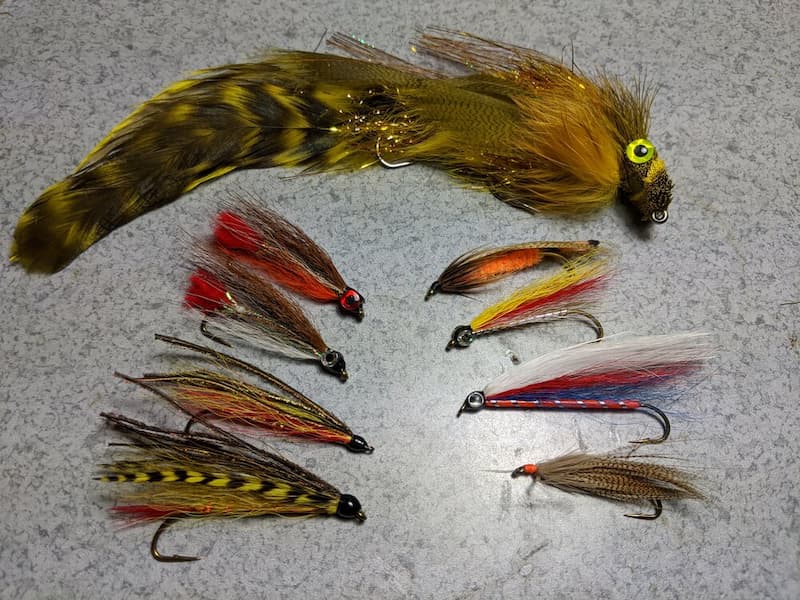
Ways To Rig Up Streamers For Fly Fishing
I can set up my fly rod in one of three ways for streamer fishing. Depending on how strong the current is and how deep I want to fish, I can go either way. Normally, when making streamers, I use straight tippet. I’ve discovered that a tapered leader is simply unnecessary.
The three configurations below all make use of a FLOATING WEIGHT FORWARD fly line. In the past, I’ve tried using sinking fly line, but I found it to be challenging to cast and I lost some flexibility in depth adjustment.
The goal is to get the streamer into the fishy water. This typically means that going deeper is preferable. Increasing weight at the fly or on the line is the only way to make a streamer deeper. As a very last resort, I add split-shot.
Slow currents or shallow transitions into deeper water – 3 ½ feet of 3X or 4X from the fly line to the fly, a fluorocarbon tippet. This is the ideal situation for drifting a fly from a shallow river bank into a deeper transition. Many times in this circumstance, trout will be “looking up.”
Moderate currents or 3 to 5 feet deep – A few more feet of 3X fluorocarbon tippet, roughly 5 to 6, will be added. A streamer with lead eyes or a tungsten bead will then be tied on.
Fast currents and deep water – With a length of sink line, I set up my fly line. Intouch Level T is a tungsten-containing product that Rio sells. Making a sinking tip that will range in length from 4 to 7 feet, I’ll use a loop-to-loop connection to secure it to my floating fly line.
Consider combining these line setups to suit the water conditions.
Choose Streamer Patterns
Attractive and imitation streamers are the two types of streamers available. A replica streamer, such as a sculpin or a Rainbow Baby Gonga, is made to resemble a riverside minnow that trout might encounter. A Kreelex or Sparkle Minnow is an example of an attractor that is made to resemble food, but not necessarily to look like any particular food. Both are fished similarly, employing the earlier mentioned methods, but using imitation streamers requires a little more thought. Sculpins are a good illustration. The sculpin’s lack of a swim bladder, which makes it unable to control its depth in the water column and forces it to live on the bottom, is its most significant physical characteristic. So your sculpin imitation should be on the bottom as well. A sculpin imitation that moves along at 6 inches from the surface is not very convincing. A sculpin pattern six inches below the surface has been effective in catching many fish, but it is a poor imitation. Therefore, when fishing an imitation, be sure to be familiar with the habits of the fish you are fishing. Since an attractor is not made to resemble any particular fish, it can be fished at any depth. Attractors are merely created to appear and behave like food, which can be found at any depth.
Strategies For Streamer Fly Fishing
Fly Fishing To Structure Parallel To Bank
The best way to offer your gift will depend on where you are in relation to the trout holding area. The woody waste that coats the streambanks serves as a frequent holding structure for trout. A log is frequently pushed to run parallel to the current by the current.
When this occurs, I like to stand directly upstream of the log. STAY AT LEAST 35 FEET AWAY because the trout is facing in your direction. My cast is ¼ down and across, but frequently I can get a backcast to go straight upstream, which greatly increases my casting distance.
By using this technique, the streamer fly can be presented to the trout in two different ways. The streamer is first “flung” or swum across the trout’s nose.
In the second technique, the streamer is cast beyond the trout and then stripped in “flanking” it from a distance of between 18 inches and 2 feet. This technique should be used last because a bait fish swimming by a trout predator is typically a little out of the ordinary.
Streamer Fishing To Mid-river Structure
The most likely scenario that you will come across is this one. Trout “hotels” can be created out of boulders, tree stumps, and even man-made structures. Frequently, the fish will hold right in front of or closely behind the obstruction.
I’ve discovered that the best positions in this scenario are upstream and to the side. The cast must be made ¾ across the current for the streamer to drift in a straight line directly in front of the trout’s nose.
One little tip is to start this swing technique an additional 20 feet upstream from the fishy structure. This enables you to get a sense of the current and the necessary amount of mend to achieve a nice drift or swing. I’ve even caught some nice trout this way!
Fishing With A Streamer: Retrieve Techniques
Strip it, applying a bit of action to the streamer can make all the difference streamer fishing. Fly fishers can catch and release their catch during a special 30-day period on a nearby river. A variety of nice trout between 8 and 14 inches long are stocked in the river. Additionally, some monster breeding stock is planted along with +20 inch browns and rainbows.
I bring this up because these stockers enjoy streamers that are aggressively stripped in. I’ll pull in three to four feet of fly line when I say something is aggressive. Although the trout find this completely unnatural, I’ll consistently catch refusals if I use a short strip that more closely resembles what a bait fish might do.
Give it a Twitch, my first trip to The bi-annual travel schedule was established by Arkansas. Lunch was the first gathering of the group. We all had fish in our nets, so of course the boasting began, but Bill had easily caught three times as many as the rest of us.
We were all using the same basic equipment, a Zonker streamer that mimicked shad that was being swept through the dam as we fished. After questioning Bill, we learned that he had moved the fly line during the drift by three or four inches.
This motion consisted of a small strip followed by letting the current pull the fly line back out; no line was recovered. Because of this, the streamer had a slight flutter, which the trout loved.
Can You Streamer Fly Fish In Lakes?
YES! A lake is a fantastic place to go streamer fishing. For bluegills, smallmouth bass, and pike, this is the preferred technique. Considering that this could be an entire article by itself, a couple of quick points.
As soon as the streamer touches the water, let it sink. How far the streamer will sink is dependent on those obvious things like the weight of the streamer fly, but using floating line may not let the streamer get down to the fish.
Don’t be hesitant to use large streamers. A pike streamer can be 6 to 8 inches long! You might catch a lot of bluegills with a small size 8 tied on, but you won’t hook a smallmouth or a pike.
History Of Streamer Fishing
The first real mention of the streamer appeared in the fishing gazettes of the 1850s, despite the fact that it was likely used by the Macedonians. The streamer is generally thought to be a North American invention. However, it wasn’t until Theodore Gordon, the inventor of the American dry fly, started writing about his fly, the Bumblepuppy, in the early 1880s that it took a serious turn. The basic form of this fly was a white and brown fly, though it underwent many changes. The Land-locked Salmon and Brook Trout rivers in Maine, however, were where the streamer fly reached its zenith in the 1920s and 1930s. The Mickey Finn, the Gray Ghost, and the genesis of the traditional streamer all originated here. Since then, the streamer has evolved into one of the most appealing and successful fly-tying techniques. The streamer has evolved from its humble beginnings to become one of the best representations of minnows, sculpins, and other swimming species. It is also an expression of the fly tier’s art.
Definitions of the Streamer The classic definition of a streamer is a long-shanked fly tied with a feather wing. Contrast that with the Bucktail, which is a long-shanked hook with a wing made of bucktail or another type of hair. However, the term “streamer” has come to refer to any fly that is used to mimic a minnow or leech. The streamer now includes swimming flies like Double Bunnies, Articulated Leeches, and Woolly Buggers.
The End
The most straightforward and challenging fly fishing technique is streamer fishing. You must cast across the current at its most basic level, letting the current pull the fly along. In contrast to nymphing or using a dry fly, where the line is slack and you don’t feel the fish take, you are fishing with what is known as a tight line, so if you bump a rock, hit bottom, or have a fish take, you will feel it. What could be easier than to cast across and let the current do the work?
It is acceptable for the fly to move against the current because a streamer imitates a food form like a minnow or a leech that can actually move in the water (unlike nymphs or dries that can only imitate food forms that can float with the current). Any movement against the current is referred to as drag in dry fly fishing or nymphing and is bad. Action in streamer fishing refers to movement against the current, and it is a good thing.

